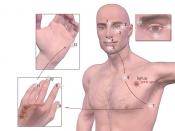Emotion-Focused Approach � PAGE �1�
Running Head: EMOTION-FOCUSED APPROACH
Emotion-Focused Approach
[The Writer's Name]
[The Name of the Institution]
Emotion-Focused Approach
Introduction
According to the expert analysis, EFT has continued to grow and develop as a model of couple therapy. Outcome research has constantly validated the effectiveness of this model and its ability to create lasting change, even by means of high-risk populations. As in the 1996 edition, the theory of change, the procedure steps, and the interventions of EFT are described in detail, albeit by new scientific refinements included and improved descriptions (Anderson, J., 2001).
As a model of intrusion, EFT arose from systematic surveillance of couples in therapy and the process by which they succeeded in repairing their relationships. New models of marital suffering, such as Gottman's model, also have grounding in the observation and the coding of exact interactions flanked by intimates, as do models of adult close relationships such as accessory theory.
Moreover, it is perhaps not astonishing, then, that there is consonance in the middle of EFT as a model of intervention, researched evocative models of distress, and relational theories such as accessory. Distressed couples taught Les Greenberg and me, the inventor of EFT, how to describe the procedure of alter outlined in EFT and the interventions that endorse this change procedure. Moreover, the primary EFT manual was written as part of the first result study, which compared EFT to untreated couples and couples who finished a behavioral communication and skills training intrusion. The consequences of EFT in this primary study were imposing sufficient to spark another two decades of research on EFT(Elliott, R., Watson, J. C., 2004).
What is Functional Assessment (FA)?
No doubt, this study utilized evocative assessment methods to expand hypotheses regarding the function of lunchtime behavior troubles for three...


